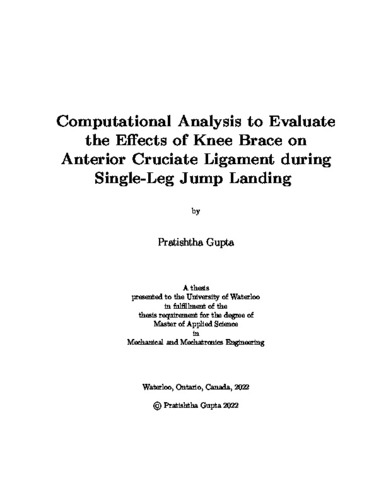| dc.contributor.author | Gupta, Pratishtha | |
| dc.date.accessioned | 2022-12-21 20:03:04 (GMT) | |
| dc.date.available | 2023-12-22 05:50:06 (GMT) | |
| dc.date.issued | 2022-12-21 | |
| dc.date.submitted | 2022-12-16 | |
| dc.identifier.uri | http://hdl.handle.net/10012/18984 | |
| dc.description.abstract | Injury and musculoskeletal diseases in the knee due to excessive loading at the ligaments
can cause mechanical instability to the joint. Knee bracing has been commonly used to
support and provide external stabilization to the joint by restraining its motion and redistributing
loads acting on the ligaments. Several studies have been conducted to quantify
the effectiveness of knee braces in ligament injury prevention during static and quasi-static
loading conditions. However, studies to assess them in dynamic loading conditions remain
limited.
The aim of this study was to determine the effects of the mechanical design of the
Stoko K1 knee brace on the strain behaviour of the Anterior Cruciate Ligament (ACL)
in dynamic loading conditions computationally using Finite Element (FE) analysis. The
Stoko knee brace evaluated in the current study utilizes a compliant design that has a
system of non-extensible pre- tensioned cables running through a compression tight along
designed pathways to stabilize the knee mechanics. An FE model of the knee brace was
developed on an existing FE model of a knee. The FE model was validated in quasi-static
varus/valgus loading conditions by comparing the effective load reduction at the knee to
experimental test data available. Single-leg jump landing simulations were then conducted
in braced configuration by inputting the muscle forces and joint kinematic/kinetic profiles
for ten participants. ACL strain behaviours for post-ground contact duration of 200ms
were compared between braced and unbraced configurations to assess the efficacy of knee
brace in reducing ligament injury.
The results showed that the effective load at the knee reduced with the brace compared
to without the brace during quasi-static varus/valgus loading, similar to the experimental
results. Load reduction in braced configuration compared to unbraced configuration was
4.15% during valgus and 29.3% during varus loading condition. During the jump-landing
activity, the mean ACL strain in braced configuration increased to 6.59 ±2.41% from 5.54
±2.41% (p = 0.024) in unbraced configuration. The mean time taken for ACL to peak
decreased from 80.66 ±27.14 ms in unbraced configuration to 61.33 ±24.61 ms (p = 0.007)
in braced configuration. It was concluded that the mechanical design of the knee brace
could cause the ACL strain to increase during dynamic loading. However, further studies
are necessary to evaluate the changes in muscle firing patterns in the braced configuration,
their effect on ACL strain behaviour and the effect of knee brace on other knee ligaments
such as the Medial Collateral Ligament and Lateral Collateral Ligament. | en |
| dc.language.iso | en | en |
| dc.publisher | University of Waterloo | en |
| dc.subject | Knee Brace | en |
| dc.subject | Single-Leg Jump Landing | en |
| dc.subject | Anterior Cruciate Ligament | en |
| dc.title | Computational Analysis to Evaluate the Effects of Knee Brace on Anterior Cruciate Ligament during Single-Leg Jump Landing | en |
| dc.type | Master Thesis | en |
| dc.pending | false | |
| uws-etd.degree.department | Mechanical and Mechatronics Engineering | en |
| uws-etd.degree.discipline | Mechanical Engineering | en |
| uws-etd.degree.grantor | University of Waterloo | en |
| uws-etd.degree | Master of Applied Science | en |
| uws-etd.embargo.terms | 1 year | en |
| uws.contributor.advisor | Chandrashekar, Naveen | |
| uws.contributor.affiliation1 | Faculty of Engineering | en |
| uws.published.city | Waterloo | en |
| uws.published.country | Canada | en |
| uws.published.province | Ontario | en |
| uws.typeOfResource | Text | en |
| uws.peerReviewStatus | Unreviewed | en |
| uws.scholarLevel | Graduate | en |

